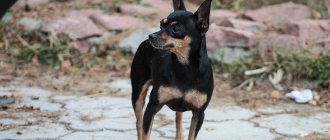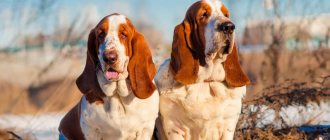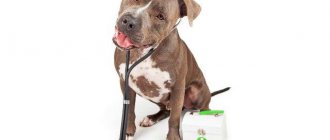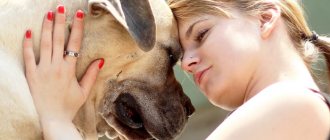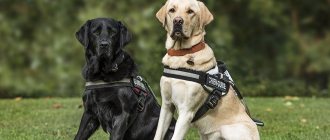Dogs are one of the most popular pets for families with children around the world.
And this is not without reason, because these are loving, faithful friends and excellent companions who will help teach a child not only responsibility, but also unconditional love. The secret is to find the perfect breed for your family that will best suit your lifestyle.
When choosing a dog for a child, you should take into account a large number of factors. Pay attention to the dog's size, temperament, activity level, health and grooming needs. Well, we hope that our selection will help you make the right choice.
- Small dog breeds for children
- Medium dog breeds for children
- Large breeds of dogs for children
Suitable breeds
There are quite a lot of them. Let's briefly look at 30 that are suitable for keeping in an apartment with children of different ages.
Little ones
They do not take up much space in the house, eat little and usually do not require long walks. But even a small dog will have to be raised, socialized and taught basic commands in the first year of life. Otherwise, his behavior will become problematic.
Chihuahua
Miniature decorative dogs with a brave character. Very loyal, often even jealous. Sometimes they choose the main favorite from the family.
Chicks don't need long walks. But they do not like to stay alone at home for a long time: they constantly need communication with their owners.
Chihuahuas come in short-haired and long-haired varieties and come in a variety of colors. They vary in size.
Russian toy terrier
Many people confuse him with the Chihuahua. It is not difficult to distinguish them. Chicks have an apple-shaped head, bulging eyes, and a stocky body. The little toys are built more elegantly: they resemble a fawn with large ears.
Toys come in different colors, short-haired and long-haired. By nature, the dogs are active, very emotional, sociable, affectionate and playful. Not bad watchmen.
Yorkshire Terrier
A small decorative dog with a spectacular appearance. Yorkies are very energetic, playful, hardy, and smart. Excellent companions for everyone: children, adults and the elderly. But to keep your Yorkie from being mischievous at home, you will have to train him.
Long fur requires careful care. To make their lives easier, most owners give their pets a haircut: there are dozens of models. Dogs shed minimally, and their fur is considered low-allergenic.
Cavalier King Charles Spaniel
A toy spaniel with an affectionate, energetic character and charming appearance. The dogs are smart, friendly, and well trained.
Tireless participants in children's games, as well as listeners and consolers. They love communication and tactile contact, so it is recommended to bring them into large families, where they will be provided with attention and petting and hugging.
They don’t tolerate loneliness well, they can cause destruction at home.
Welsh Corgi (Pembroke and Cardigan)
Small shepherd dogs with an elongated body and short legs. The Pembroke and Cardigan varieties are similar in appearance and character. Dogs are very charming. They captivate with their good nature and intelligence: they love children, get along with cats, and are easy to train.
Sometimes the shepherd awakens in the pet, then he begins to bite family members, especially children, on the heels: this is how he gathers the herd. It is better to wean yourself from this habit immediately.
Dogs love their owners very much and need communication. They willingly play with children and tolerate their affection.
Welsh Corgis should be protected from jumping from heights: due to their long body and short legs, there is a high risk of injuring the spine. But they can run around to their heart's content.
Maltese (Maltese dog)
A small dog with a luxurious white coat. A very sociable, inquisitive, playful dog. Loves to bark from excess of feelings.
She loves to communicate with her owners and is good with children. Good-natured towards other pets.
Maltese doesn’t like to sit at home alone for a long time: he starts to get bored, he might spoil something or chew on it.
The coat requires care, but can be cut shorter. The Maltese hardly sheds and is a low-allergenic breed.
Bichon Frize (French lapdog)
Cute dog with white curly fur. Kind, affectionate, playful and very energetic. He gets along well with children, is very sociable, and loves to bark loudly.
The Bichon is not suitable for busy people who are away from home for a long time: the dog will feel sad when alone.
Bichons have no dog odor, hardly shed, and are a hypoallergenic breed.
Pomeranian Spitz
A baby with a luxurious thick fur coat. She loves her owners, gets along well with children, but does not like and will not tolerate familiar treatment.
Spitz barks frequently and loudly. They show good security qualities.
Despite its touching appearance, the Pomeranian has a stubborn character. Education must be consistent, otherwise the pet will take power into its own paws.
Pug
Great for keeping in an apartment with children. He has a balanced, calm disposition. The dog is funny, friendly and sociable.
Puppies are active and playful, while adult pets prefer quiet walks and short runs. And rightly so: heavy loads are dangerous for them.
Dogs don't just bark. They are happy to lie next to their owner. They love to eat, but you shouldn’t overfeed them: there is a high risk of obesity.
Pugs need temperature control: overheating and hypothermia threaten their lives.
Poodle (toy and miniature)
Extraordinarily sweet, intelligent, emotional dogs with beautiful curly hair. They are distinguished by their good nature, playful disposition, get along well with children and are excellent companions.
Small poodle varieties can be more timid than their larger counterparts. This can be corrected by proper socialization. Poodles are obedient and easy to train.
They cannot stand harsh treatment or punishment.
Wool requires grooming and trimming. The breed is considered hypoallergenic.
Italian Greyhound
A miniature representative of greyhounds with an aristocratic appearance. Italian Greyhounds love their owners very much, need communication, and love tactile contact.
Dogs are emotional, curious and energetic. They will willingly play outdoor games with children. But they can also do harm, so you shouldn’t spoil them.
Italian Greyhounds are in good health. But in puppyhood, you should take care of the fragile bones.
Average
If you like medium-sized dogs, then take a look at the following list of 9 breeds. Perhaps one of them will suit you.
French Bulldog
Charming and friendly, Bulka will become an excellent friend to a grown-up child, who will not bother him with unpleasant pranks. The dog is sociable and cannot imagine life without close communication with his owners.
Bulldogs are smart, but can be stubborn. The owner will have to be smart and patient in training.
Bulldogs do not need long walks; a little activity is enough for them. Some people don’t like their slobbering, but dogs don’t bother their owners with needless barking.
They do not tolerate heat well and need air conditioning.
English bulldog
An adorably terrifying dog, muscular, intelligent and unflappable. Cute lazy, stubborn, fat and charming. A loyal friend and protector of the owners.
Children are treated warmly and with love. He tolerates their squeezing and is even ready to play.
But to a greater extent he is a homebody. Enjoys lying next to the owners' sofa. He doesn't need long walks, but exercise walks are important for his health.
He can be stubborn and lazy. His mentor must be patient, persistent and preferably experienced.
Disadvantages include drooling, snoring, a tendency to flatulence and obesity. But for lovers of the breed, the benefits outweigh.
Chinese Crested
Loving and loyal dogs with an unusual appearance. Sociable, affectionate, gentle and even dependent on the attention of their owners. They get along well with children who already know how to communicate properly with a pet.
There are naked and downy varieties. Both require careful coat and skin care. The dog's fur does not have a dog smell and almost does not shed.
The breed is not suitable for busy people: pets do not tolerate long-term loneliness, which they notify neighbors about by howling.
The “crested” ones should be protected from overheating and hypothermia, and the hairless variety should also be protected from skin damage and sunburn.
Poodle (small)
Smart, friendly dog with an elegant appearance. Active, affectionate, obedient, tireless participant in children's games.
The dog is well trained and tries to please its owner. You can do agility with it.
Spaniels (English and American Cocker Spaniels, Russian Hunting Spaniels)
These hunting dogs are distinguished by their good-natured disposition, intelligence and energy. Properly raised pets will become good friends for a child.
Dogs are inquisitive, love walks, active games, and willingly frolic with children. However, they will not tolerate discomfort and pain; they can fight back.
English and American spaniels can bite a child when playing: this behavior should be stopped immediately.
The long coat of Cocker Spaniels, especially American ones, requires careful grooming. It’s easier in this regard with a Russian spaniel.
Some Spaniel breeders believe that of the 3 varieties, it is the Russian Hunting Spaniel that is distinguished by the greatest friendliness and obedience.
Beagle
A hunting dog with an energetic, playful and sociable character. A fidget who doesn't like loneliness.
Dogs need regular active walks and physical exercise, which will save the owner’s apartment from destruction. The dog is always happy to run and play with children outside. Just first you will have to properly practice the “Come to me!” command with your pet, otherwise he may chase a pigeon or cat and get lost.
It is better not to have cats, birds or other small animals with them: beagles have too strong a hunting instinct.
Nannies or security guards
Dogs that get along with children should definitely include four-legged nannies and guards. The former are distinguished by their extraordinary overprotection and tolerance, and the latter by their impressive strength, which allows them to protect the owner from any intruders.
Saint Bernard
Balanced and very good-natured, Saint Bernards are not without playfulness. They love to play pranks with babies and take on the role of nanny with great enthusiasm. Their only drawback is intense salivation.
Siberian Husky
Love for babies is in the husky's blood, so you can even trust him with a baby without fear. Despite his friendliness and excellent learning abilities, he is distinguished by his stubbornness and desire for leadership. Because of this, his training should only be done by an adult.
Collie (Scottish Sheepdog)
Collies are peaceful, patient, smart and courageous. Thanks to these features, they are often used as nannies, but they are not suitable as a bodyguard due to their innate lack of aggression towards humans.
Bobtail (Old English Sheepdog)
Bobtails are famous for their playful nature. They love to play pranks with the kids, but they also take the role of nanny very seriously. Because of this, during a walk, a strong impression is created that it is the dog who is walking the baby, and not vice versa.
English Mastiff
Despite its formidable appearance and good guard qualities, the mastiff is an example of calm and steadfastness. Due to its phlegmatic nature and large dimensions, it is not suitable for overly active children and infants. It is better to take such a dog for teenagers or for homebodies in elementary school.
German Shepherd
The most popular service dog is often purchased for the family. It's all about her devotion and complaisance. The shepherd dog unquestioningly recognizes the authority of the owner and can even be trained under the guidance of children.
Rottweiler
The Rottweiler is similar to the German Shepherd in many ways. He is also one of the TOP 10 smartest four-legged animals, is endlessly devoted to his owner and is famous for his protective qualities. The only thing that distinguishes them is a greater distrust of strangers. Rottweilers are very patient with the kids in their family, but they see everyone else as a potential threat. For this reason, these animals need very competent upbringing.
Doberman
Another example of an ideal and obedient protector is the Doberman. With timely socialization, he becomes a full-fledged family pet, and not at all a “fiend of hell.” Thanks to its independence, the dog is perfectly oriented in the situation and, without additional commands, distinguishes between the time for pranks with the children and their protection.
Moscow watchdog
The Moscow Watchdog is the result of mating a St. Bernard and a Caucasian Shepherd, so its character combines a favorable attitude towards children and a developed protective instinct. Due to its large size, it is better to keep such a pet in a private home.
German dog
Great Danes are ideal protectors and bodyguards. Due to their phlegmatic nature, they can even live in an apartment, but only if there is sufficient space. The only disadvantage of these noble four-legged animals is their poor health and short life expectancy.
Staffordshire Bull Terrier
Because of their past, Staffords often receive accusations of wanton aggression. In fact, the opinion about the viciousness of this breed is wrong. Modern Staffords are the kindest, human-oriented creatures. Unlike the Rottweiler, they are with great pleasure ready to provide their belly to any baby they meet.
Alabai
Fearless Alabai were bred for protection, so distrust of strangers is in their blood. Despite this, they do not see any danger in the kids at all. Alabai are always welcoming to them.
East European Shepherd
The East European Shepherd is the closest relative of the German Shepherd. It is endowed with a similar character, but more modest dimensions. It is also worth noting less temper, which is very important when dealing with little pranksters.
Irish Wolfhound
The cruelty of Irish wolfhounds only manifests itself during the hunt. Among the family, these four-legged animals are completely harmless. They are indulgent towards their little owners and, up to 2 years old, support any of their fun with puppyish enthusiasm.
Schnauzers
This should include the Giant Schnauzer and its closest relative, the Black Russian Terrier. The first representative is as restless as children, so first of all he makes friends with his little owners. The Black Russian Terrier is calmer, but this does not prevent him from taking an active part in children's games and even some pranks.
Boxer
Playful and energetic boxers do not choose their favorites and become attached to all family members without exception. Thanks to their good security qualities, they can be entrusted not only with the role of a friend, but also with a bodyguard.
Jack Russell Terrier
The most popular terrier for children is the Jack Russell. This is a typical “energizer”, ready to play with its owners for days on end. It is important to understand that the terrier did not tolerate it. You can't treat him like a teddy bear. Otherwise, you may get a “bite” response.
Difficult rocks
It is difficult for a novice dog breeder without experience to raise a pet prone to dominance and making its own decisions. Aboriginal, fighting, and service dogs are distinguished by these qualities:
- likes;
- husky;
- Alaskan Malamute;
- Akita Inu;
- Shiba Inu;
- Basenji;
- Doberman;
- Rottweiler;
- Ridgeback;
- Cane Corso;
- bull terrier;
- pit bull;
- Great Danes;
- boxer.
Examples of successful experiences of these dogs living in families with children do not negate the potential danger of these breeds. Plus, they require much more effort to train than family companion dogs.
Pets not suitable for children
Most dogs are kind, sweet and friendly. Depending on the breeds, they can perform different functions: hunt, protect and serve for the benefit of people. Due to the functions they perform, they must have special qualities, being large, intimidating, courageous and obedient.
When choosing a pet, you must pay attention to its character. Hunting, service and guard dogs are completely unsuitable for children. It is also worth giving up fighting ones.
They do not bond well with children and can harm them. Even if the dog is used to the child, there is a high probability that it may see him as a threat and simply become jealous of his owners.
It is also worth abandoning decorative breeds. They are too capricious and do not like to be tormented and squeezed. In response to excessive activity on the part of the baby, the pet may respond with aggression.
Among the medium-sized breeds, such as Akita Inu, there are those who love themselves more than adults or small owners. Pride prevents them from getting along with children and therefore makes them completely unbearable.
For children under 7 years old
A dog always means additional troubles and expenses. Therefore, you need to think about whether you have enough strength and resources not only for a small child, but also for a pet. Their communication will have to be constantly monitored.
Miniature decorative breeds are not suitable for children. Small dogs are often nervous and jealous, and are easily injured. Larger friendly pets are good:
- lapdog;
- pug;
- poodles (small and large);
- Welsh Corgi;
- Labrador;
- Golden retriever;
- German Shepherd;
- Bernese Mountain Dog.
While a child is 1, 2 or even 3 years old, it is difficult to explain to him how to properly communicate with a dog. Children from 4–5 years old can already learn the rules of handling four-legged animals:
- do not grab the tail, ears, muzzle;
- do not bother while eating and sleeping;
- do not touch suddenly from the back;
- pet and play taking into account the dog’s wishes;
- do not frighten, do not tease;
- do not shout;
- don't hit.
At 6–7 years old, a child is quite capable of helping to feed and care for a pet. Walk your pet under adult supervision if you are able to keep it on a leash.
Different situations
It is recommended to pay special attention to the age of future friends. It influences the building of relationships - after all, the four-legged dog accepts the one who cares about it as its main owner.
A child under one year old and a small puppy
Puppies and newborns are not the best tandem. In this situation, the desire to acquire a four-legged friend belongs exclusively to the parents.
It should be understood that a grown-up dog will perceive his little owner solely as a playmate. For this reason, it is recommended to prioritize safety by choosing a large, good-natured pet or nanny dog.
Preschooler and puppy
Dogs and preschool children also require increased attention. It is better to start teaching a small child how to properly handle a dog and introduce him to some responsibilities after 3-4 years. That is, before this age, you should focus on breeds for newborns, and after that, on those that do not require complex care.
Schoolchild or teenager – and puppy
Primary schoolchildren and teenagers are more independent and responsible, so they can be completely trusted with the choice of their future pet. A child growing up with a dog less than a year old has every chance of becoming its main owner. To do this, he should take on most of the responsibilities, including the direct education of his four-legged friend.
Adult dog and newborn
An adult dog that has been living with you for a long time and a small child who is the second in the family can provoke a conflict based on jealousy. In this situation, it is important to conduct the first acquaintance correctly:
- Take your pet for a walk, reducing its level of excitement.
- Show the newborn by allowing the animal to sniff or lick it.
- Direct the four-legged attention to the game or take him to the kitchen for lunch.
The main task is not to deprive your pet of its usual attention in favor of the baby. Encourage curiosity and do not drive the dog away from the crib. Give him time to get used to the new smell and try to reinforce positive associations with praise for careful licking and other displays of affection.
For children 7–14 years old
At this age, children are already more conscious. The entire list of 30 breeds will do here. It all depends on your capabilities, preferences, lifestyle and character of the child.
Every child and every family will find a pet to their liking. For an active child of 8, 10 or 12 years old, a spaniel, beagle, collie and other temperamental breeds are good. A pug or an English bulldog will be a friend to a calm child. For children who are interested in agility classes, poodles and shelties are suitable.
Children who live with dogs get sick less
0
See all photos in the gallery
Staying in the same house with a dog increases the immunity of children of any age, including infants. According to research, children who are in the company of a dog are much less likely to suffer from respiratory and other infectious diseases. Many people try to protect their children from unnecessary germs from childhood by isolating them from the outside world and placing them in sterile conditions. This harms the immune system and weakens it, while the microbes living on the dog work a miracle - they stimulate the child’s body’s defenses.
For children 15 years and older
Giving a dog for a teenager's birthday is a great idea. But only if the child himself wants and is ready to spend a lot of time working with the dog.
Imposing a pet on a child to teach him responsibility is a bad idea. Responsibility is fostered through the example of parents and the desire of the child to communicate with the animal.
It is also worth assessing how the pet fits into the teenager’s plans in the next 10–15 years, which is approximately how long a dog will live. Even if the child has a great desire to take care of the dog, but there is no time, it is better to wait for better times.
Criteria for choosing a four-legged friend for a child
The choice of a four-legged friend should always be approached responsibly, especially when it comes to a child. First, it is worth considering the following criteria: character, size, gender and the presence of allergies in the child.
Character
Dogs, like people, can be different. Kind, serious, active, capricious and calm. If your child likes to spend time outside, play in the sandbox and climb slides, then you should give preference to a large, fluffy and active dog.
For diligent guys, you can choose a small but patient dog.
You should first pay attention to how well the animal and the child get along and only then proceed to purchase.
Size
Most often, children choose big dogs. They are soft, fluffy and kind. Large pets are easy to play with, so they are ready to patiently endure all the torment.
Large dogs are also ready to ensure the safety of the owner and, as practice shows, behind a large body hides a vulnerable and very faithful soul.
Small dogs are more capricious. They tire quickly and due to their small size, these small creatures are very easy to harm.
Male or female
The gender of the pet plays an important role. In addition, it has a significant impact on the appearance of the pet. Bitches are smaller in size and visually more pleasing to the eye. Males are stronger, have a prominent chest and are less capricious. In addition, the owner of the bitch will have to take care of future offspring.
Girls get along better with kids, while boys like to take care only of themselves.
Safety
Any dog can pose a danger to a child. Even the smallest one. Therefore, you should carefully approach the purchase of a pet: look for conscientious breeders, choose a pet with a stable psyche.
Plus, the pet will have to be trained and socialized. After all, even a purebred puppy needs training so that its behavior is manageable.
Let's evaluate the problems
Almost every child secretly or openly dreams of a dog. A little person also wants to take care of a living creature, communicate in a language that only they understand, and spend time together. The teenager does not think about household difficulties. And not because he is selfish and callous. He just doesn’t know life, has no experience communicating with people or animals.
And we, adults, have been aware of this for a long time. And we understand perfectly well that numerous troubles will fall on our shoulders as an additional burden. Cash costs will increase significantly: special food, veterinary care, daily hygiene, toys, special training... What if the dog is purebred? Exhibitions, competitions, and issues of improving the performance of the breed are immediately added.
But what lies on the other side of the scale? The interests of your growing child. His desire and willingness to bear responsibility for the pet. And this is worth a lot! Much more than the cost of maintaining any animal. So don’t dismiss the initiative of the younger generation.
Numerous observations prove that having a dog in the family:
- Makes the child kind, responsive, socially active.
- Instills respect and trust of the teenager in adults and in society as a whole.
Let's think about what needs to be done so that both the teenager and the animal, and, of course, us adults, feel comfortable living together in the same house.
Hypoallergenic dogs
Is it possible to get a dog for a child with allergies? It’s impossible to say for sure. Each person's reaction to a particular dog is individual. Hypoallergenic breeds are simply those breeds that spread fewer allergens around them.
It is preferable that the dog hardly sheds. Smooth-haired dogs without thick undercoat are also suitable. Breeds with increased salivation, such as bulldogs, are not suitable.
Here is a sample list of suitable breeds:
- Yorkshire Terrier;
- smooth-haired chihuahua;
- smooth-haired toy terrier;
- Italian Greyhound;
- poodles;
- Bichon Frize;
- Maltese;
- Chinese Crested.
It is believed that females are less allergenic than males.
It is advisable that the child spend at least 1–2 hours in the home of the owners of the chosen breed or with the breeders. If there is no negative reaction, then there is a chance that the allergy will not arise in the future.
What are the benefits of a dog for a child?
Psychologists say that if your daughter or son comes up with the idea of getting a dog, this indicates that subconsciously he or she is ready for responsibility . But before buying, it’s better to take them on an excursion to those who have a pet, so that they can see what troubles await them.
Four-legged animals help a person fight insecurities and complexes, and improve the baby’s health. He will also become more responsible, more open in the company of his peers, and get accustomed to the regime.
Dog breeds for girls and boys
For girls, lap dogs, Toychiks, Chishkas, Yorkies, Chinese Crested, Poodles, Cavalier King Charles Spaniels, and Shelties are suitable. They can be combed, decorated with bows, collars with rhinestones, or dressed in overalls in cool weather.
But a boy won’t really like walking with such dogs. Their friends may make fun of them. True, small and large poodles, shelties and even a lively Yorkie without a glamorous haircut can look quite organic next to a boy.
Boys will love Beagle, Spaniel, Labrador, Golden, German Shepherd. However, these and other breeds from our list are also popular with girls.
Dog for special children
Today, dogs are used to improve the health of children with autism, mental retardation, and cerebral palsy. Communication, tactile contact and exercises with a dog reduce anxiety levels and help sensory development and socialization of such children.
For canistherapy, companion dogs with a stable psyche are used, often Labradors and Goldens, as well as dogs of various breeds that love to communicate specifically with children. Ideally, animals should be trained.
You can communicate with such dogs in special centers. Some parents want to bring such a pet into their apartment. However, here you need to remember that caring for a dog is an additional burden for adults.
Is it worth it? Let's weigh the pros and cons
Parents are usually in no hurry to get a pet, even if the child really wants a dog and promises to be the most obedient. They understand that most of the care and upbringing will fall on them, not to mention the financial side. But there is another side to the coin.
Of course, the dog will cause a lot of trouble. But for children there are many advantages from her living in the house:
- Development of the best qualities.
Constant care for a living being teaches children responsibility, empathy, and kindness. They mature faster and begin to analyze the consequences of their actions. - Friend and psychologist.
It is especially good to have animals for quiet, withdrawn children who have problems with communication. - New acquaintances.
While walking the dog, other children will approach the child to pet the dog. This will help you make friends. - Health promotion.
Children who grow up with animals are less at risk of developing allergies, asthma, and colds. And regular walks and games in the fresh air contribute to harmonious physical development. - Four-legged bodyguard.
Even dogs with weak protective instincts stand up for their owners in case of danger. The mere presence of a dog scares away ill-wishers - it is difficult for strangers to take away or kidnap such children.
Dogs also have a positive effect on children with developmental delays. They stimulate physical growth, improve social skills, mental and mental state in children with cerebral palsy, Down syndrome, oligophrenia, autism, and traumatic brain injuries. Treatment with the help of dogs has received a separate direction - canistherapy.
But before you buy a dog, you need to consider the disadvantages:
- You will have to say goodbye to your usual way of life.
The schedule will inevitably be adjusted to suit the pet, since it needs to be walked regularly. And trips to resorts with the whole family will become very problematic - you will have to take the animal with you or look for a “nurse” for it. - Most of the care will be on the parents.
Especially if the child is of kindergarten or early school age. He simply will not be able to fully monitor the dog. - Additional financial costs.
The dog needs to be fed a balanced diet, bought accessories for care and training, toys, and taken to the veterinarian. - Inevitable destruction.
Even the most obedient puppy will be mischievous at first: chewing furniture, shoes, wallpaper.
The most difficult are the first weeks. One of the adults always needs to be at home, help the puppy adapt, introduce him to the rules and prohibitions.
To finally decide or abandon the idea of having a dog in the house, we advise you to read our useful article on the topic “Should you get a dog?”
Gender question: boy or girl
It is believed that females are more flexible and affectionate than males. Although much depends on the character of the particular animal.
What difficulties may arise during walks? If unchecked, the cable will run after a bitch in heat or start a fight with other dogs. A pack of fighting males will gather around a female dog during the heat period: adults should walk the dog at this time.
If you plan to have a child walk with your pet, the animal can be spayed or neutered. This will reduce the risk of conflicts with other dogs.
Why are parents afraid to get a dog? The main doubts of mothers and fathers
Sensible parents realize that the main responsibility for the animal will fall on their shoulders. Therefore, before agreeing to add to the family, it is worth calmly explaining to your son or daughter some of the nuances associated with the appearance of a pet in the house:
- a puppy, like a small child, will leave puddles all over the apartment until it grows up, and someone will have to clean them up (this is especially important if the parents are at work all day);
- the puppy does not yet understand the word “impossible”, he will play and chew everything that gets in his way: furniture, magazines, rugs, wires, backpacks and fashionable sneakers;
- To prevent such behavior from becoming a bad habit, the dog must be educated: under no circumstances should you beat or scold, but patiently, day after day, explain to your pet what is good and what is bad;
- the dog must be fed properly, some breeds have sensitive digestion, and without receiving a balanced diet, they can often get sick;
- You need to walk your dog: in any weather, early in the morning, during the day and in the evening, regardless of your mood or desire to sleep;
- the dog must be trained in basic commands and must obey its little owner, otherwise it will simply break off the leash, and an escape may end in tragedy;
- The puppy grows and matures quickly and will very soon turn into an adult dog, and it largely depends on the child whether the pet will become a burden or a full-fledged member of the family.
Such a conversation will make sense if the child is already 8-10 years old; younger children will most likely not understand more than half or will ignore it. Experts advise children of primary school age to get a dog, and there are good reasons for this.
Dogs for children.
